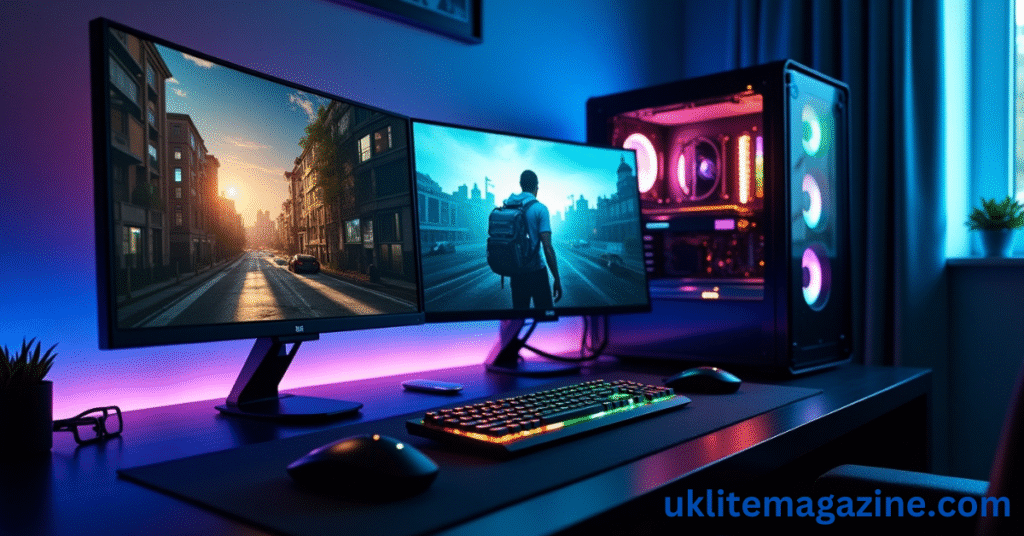Ray tracing is a cutting-edge graphics technology that brings lifelike lighting, shadows, and reflections to modern games. But it’s also very demanding on your hardware. If you want smoother gameplay and top-tier visuals, you need to optimize your gaming PC the right way. This guide will walk you through the best settings, hardware tips, and tweaks to get the most out of ray tracing without compromising performance.
What Is Ray Tracing?
Ray tracing simulates how light behaves in the real world. Instead of using traditional lighting models, it calculates how rays of light bounce off objects, making shadows softer, reflections more realistic, and lighting effects more immersive.
However, this realism comes at a cost. Enabling ray tracing can significantly reduce frame rates unless your PC is well-optimized. That’s why balancing performance and visual quality is essential.
Recommended PC Specs for Ray Tracing
Before diving into optimizations, make sure your system meets the minimum requirements for ray tracing.
| Component | Minimum for Ray Tracing | Recommended for Best Performance |
|---|---|---|
| GPU | NVIDIA RTX 2060 / AMD RX 6700 XT | NVIDIA RTX 3080 / AMD RX 7900 XT |
| CPU | Intel i5 10th Gen / Ryzen 5 3600 | Intel i7 13th Gen / Ryzen 7 5800X |
| RAM | 16 GB | 32 GB |
| Storage | SSD (for faster game loads) | NVMe SSD |
| OS | Windows 10/11 64-bit | Windows 11 (latest updates) |
Best Settings to Optimize Gaming PC for Ray Tracing
1. Enable DLSS or FSR
Most modern ray-traced games support DLSS (Deep Learning Super Sampling) from NVIDIA or FSR (FidelityFX Super Resolution) from AMD. These technologies upscale lower-resolution images to higher resolutions using AI, allowing you to keep ray tracing on without sacrificing too much performance.
-
For NVIDIA users: Enable DLSS (preferably in Performance or Balanced mode).
-
For AMD users: Use FSR if available in the game settings.
2. Lower Ray Tracing Detail Levels
Not all ray tracing effects are equally impactful. In many games, you can choose between different ray tracing options like:
-
Reflections
-
Shadows
-
Global Illumination
-
Ambient Occlusion
Tip: Turn on only the ray tracing features that add the most visual value. For example, ray-traced reflections usually make the biggest difference, while shadows may be less noticeable.
3. Lower Non-Essential Graphics Settings
If your frame rates drop, reduce other heavy settings:
-
Volumetric Lighting – Set to Medium
-
Ambient Occlusion – Use SSAO or turn off
-
Anti-Aliasing – Use TAA or DLSS for better results
-
Resolution Scaling – 90% or lower if needed
This way, you can keep ray tracing on and still maintain smooth gameplay.
System Tweaks for Better Ray Tracing Performance
1. Update Your GPU Drivers
Always use the latest graphics drivers from NVIDIA or AMD. New driver updates often include performance improvements for ray tracing in specific games.
2. Enable Game Mode (Windows)
Turn on Game Mode in Windows Settings to prioritize system resources for gaming.
-
Go to Settings > Gaming > Game Mode
-
Toggle it ON
3. Use High-Performance Power Plan
Set your PC’s power plan to High Performance:
-
Go to Control Panel > Power Options
-
Choose “High Performance” or create a custom power plan
4. Close Background Apps
Heavy background applications (like Chrome or Discord with hardware acceleration) can steal resources. Close unnecessary apps while gaming.
Advanced Hardware Tips
1. Overclock Your GPU (Safely)
If you’re comfortable, use tools like MSI Afterburner to slightly overclock your GPU for extra performance. Be cautious and monitor temperatures.
2. Upgrade Cooling
High temperatures can cause thermal throttling. Better case airflow or adding an aftermarket cooler can help your GPU run at peak performance longer.
3. Add More RAM
If your PC is using a lot of memory while gaming, upgrading from 16GB to 32GB can prevent stuttering and boost load times, especially with modern ray-traced games.
Conclusion
Ray tracing takes gaming visuals to the next level, but it requires proper optimization to enjoy it without frame rate drops. By fine-tuning in-game settings, updating your drivers, using smart system tweaks, and ensuring your hardware meets the recommended specs, you can enjoy ray tracing at its best.
Remember, not every game is the same, so always test different settings to find the perfect balance between performance and visuals for your system.
Frequently Asked Questions (FAQs)
Can ray tracing be optimized?
Yes, ray tracing can be optimized by enabling upscaling technologies like DLSS or FSR, adjusting individual ray tracing settings (e.g., turning off shadows), and reducing other non-essential graphics options.
What PC specs do I need for ray tracing?
At minimum, you’ll need a GPU like the NVIDIA RTX 2060 or AMD RX 6700 XT, 16GB RAM, and a modern quad-core processor. For best results, aim for higher-tier GPUs like the RTX 3080 or RX 7900 XT and 32GB RAM.
How to fully optimize your gaming PC?
Update all drivers, enable Game Mode and High-Performance power plan, close background apps, use SSD storage, and tweak in-game settings. Also, make sure your PC has good airflow and cooling.
How to increase ray tracing?
To increase ray tracing quality, raise the ray tracing detail level in games—but only if your GPU can handle it. Pair it with DLSS or FSR to maintain performance while improving visual quality.

